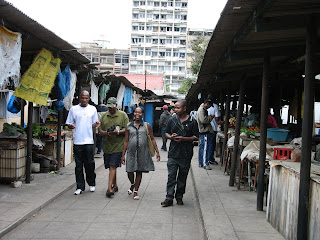The pictures posted here are from the U.S. Embassy's Election Breakfast Reception, to which the Journalism students and I were most kindly invited. More than half the students turned out to catch a kombi to Mbabane at 6:30 a.m. – quite a good turnout for that hour, I thought. The reception was packed with the Swazi elite (ministers, tribal chiefs, foreign diplomats), so I think it was an exciting event for the students. Of course, we arrived late (not everyone was ready for the kombi at 6:30, plus the driver didn't seem able to read the map I'd given him) but we got there in time to hear Ambassador Parker's toast and to take in his Q&A session on the election results in the media room. Most of the students were very attentive, and some took advantage of the opportunity to observe and speak with members of the press who were there to cover the event. A few other students took advantage of the self-serve champagne until finally chased away
by indignant embassy staff. Of course, I heard about that; in fact the entire country did, as I learned on Thursday that the undisciplined behaviour of those students was mentioned in a Times of Swaziland article the next day. Well, I guess now UNISWA knows not to send me on field trips as the only chaperone. Fortunately, my department head found the story amusing; I seem to be the only person who feels shamed by it.
It has been great to see how excited most Africans are about this first African American, son-of-an-immigrant president. His triumph embodies so many hopes of people here, both in terms of renewing faith in the notion of the American Dream and in the example people have told me it presents to African nations. Namely that a member of a formerly oppressed minority can be peacefully elected as a great country's leader. Not every single person I've met here supported Obama's election (a few thought he lacked experience), but I'd say 90% of the people I've talked to are delighted to see him take office.
Photos attached:
most of the students waiting at the kombi (we picked up 4 more on the way out)
Ambassador Parker toasting the election results (proof that at least some of the champagne made it into non-student bodies)
a man (probably a chief) in traditional garb mingles among the suits
the ambassador explaining election results on the projected computer screen
the ambassador posing with some of the students



















































